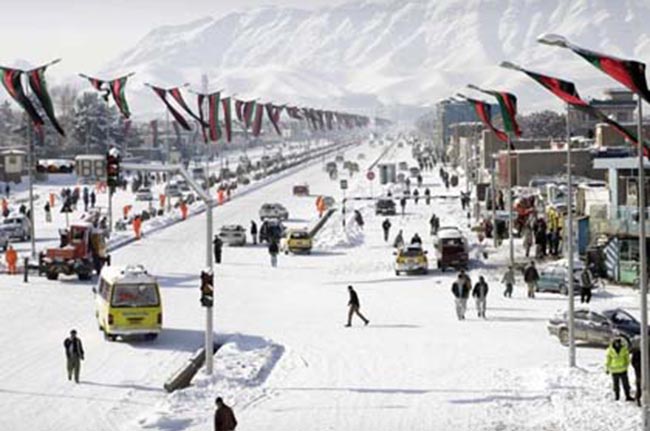According to Afghanistan's National Environmental Protection Agency (EPA) Kabul will get less snow this winter but will see higher levels of pollution. They warn that if Kabul residents do not pay special attention to what they use as fuel, the pollution levels will increase and will cause more disease. In the past few years, especially in the past few months, the percentage of patients with pollution-related illnesses has increased. Officials from Indira Gandhi Children's Hospital says about 200 children who suffer from respiratory illnesses are brought to the hospital for treatment each day as a result of increasing pollution. Therefore, the capital residents should be aware of life threatening upcoming winter. However, the Ministry of Public Health says they have plans to deal with the problem of pollution, should it increase. They say that in cooperation with the EPA they will announce an emergency situation and people will be banned from going to heavily polluted areas and schools will be closed for a period of time.
The bitterly cold winter can be more dreadful when imagine with the highest number of internal and external displacements, homelessness, jobless, widespread production of pollution and growing insecurity; since the start of the March, 2016 more than 450,000 people have been displaced in the country and thus the officials admit their failure due to insufficient financial resources to meet the challenge. Statistics show that currently the number of internally displaced people across the nation is estimated to be over 1.2 million in total. And about one million people are expected to return to Afghanistan by the end of March 2017 from Pakistan mainly due to tension strains increased between two countries.
Frequently, Afghan capital city had been recognized as one of the unhealthiest in the world, surrounded by hills that trap pollution for days. The customary smoke producing fuels, old cars, lack of standard roads, accumulation of garbage and overpopulations are counted as major factors. Afghanistan’s capital, a city built for half a million people but currently there are about four million people. Only 5 percent of Kabul’s homes are connected to actual sewerage systems, while most household waste flows straight into open roadside drains. Often their effluvia do not make it far enough to join the floating hypodermic needles and assorted muck of the Kabul River. According to health experts, air pollution is now the greatest cause of death, killing thousands of people a year – more than from war, terrorism, road accidents or HIV and Aids. Air pollution is also bad in other Afghan cities such as Herat, Kandahar, Jalalabad and Mazar.
In non-winter seasons, the emissions of old cars reportedly cause 70 to 75 per cent of air pollution in Kabul. And yet, tens of thousands of second-hand, substandard cars are imported every year, and the resulting air pollution may lead to an estimated 3,000 yearly fatalities, according to the Afghan Ministry of Health. In fact, Afghanistan has become a junkyard for old cars. Import of old cars (anything over five years) need to be banned. Those in the West who were going to pay $1,000 to impound their old cars have now found a way to make $1,000 on those old cars by selling them to people who ship them to Afghanistan, there should be strict control over the exhaust pollution of cars. Regular technical checks must be imposed. Those who don't pass emission tests must be heavily fined and the cars must not be issued permits. Over the years, due to population growth and the increasing number of such vehicles on the road, the problem has grown more challenging, and it is viewed that everybody is now susceptible to [health hazards caused by] air pollution in Kabul.
As reflected in UNEP former reports, most of the fuels used in Afghanistan do not comply with international standards and contain high levels of lead. Lead in the environment that poisons the brains of Afghan children living in urban sprawls and reduces their learning ability and other air pollutants that are threatening the public health every day, killing many citizens every day. More than 70 per cent of the country's eastern and southeastern forests have been cut down to export wood to feed neighboring country highly lucrative lumber business - an enterprise that serves only to line the pockets of Afghanistan's warlords-cum-statesmen. Moreover, the mismanagement of pistachio forests has not only damaged the eco-balance in northeastern parts of the country, but it has left tens of thousands without a source of income. However, as per article 15 of Afghanistan's constitution, the state is obligated to adopt necessary measures to protect and improve forests as well as the living environment.
Finally, the fight against environmental pollution is as much important as to fight against terrorism! Government has to update the system of garbage collection, control of walking old cars from Kabul streets, ban the import and use of substandard fuel, and as soon as possible commence the new Kabul project to expand the city; Because a large population produces a large amount of garbage, and with no systematic garbage collection and garbage disposal result larger piles of garbage and pollution. On the other hand, public media, educational system, civil society, police and etc must collaboratively work to promote the culture of how to live in a city. We should be aware that lack of public awareness and lack of culture of urban life is a big part of problem as here the last thing on people’s minds is air quality and the environment.
Home » Opinion » Kabul: Life Threatening Winter
Kabul: Life Threatening Winter
| Mohammad Zahir Akbari

